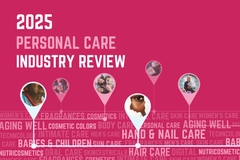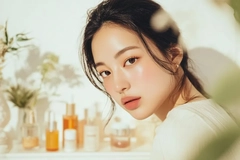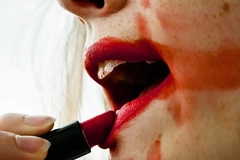US activists find Black women face greater health risks from personal care products

Black women face disproportionate health risks from the toxicity of personal care products marketed to them, according to a report by the Environmental Working Group (EWG).
The report was co-authored by Dr. Kristian Edwards, founder of Blk + Grn, a personal care brand dedicated to providing Black women with non-toxic products, created after EWG’s landmark 2016 report, which revealed similar disparities.
Edwards claims that Black women face pressure to use beauty products that help them conform to societal norms — such as relaxing their hair or participating in skin lightening.
EWG staff conducted in-store product scanning in major drug stores, local stores, and beauty supply stores across the US. The organization analyzed over 4,000 products across the beauty lineup, from hair, body, and skin care.
Approximately 80% of the items were rated moderate to high hazard, according to EWG’s Skin Deep cosmetics database, which compares personal care product ingredients with nearly 60 toxicity and regulatory databases.
Similarly, a recent Harvard University, US, study using the Skin Deep database found that stores in Boston neighborhoods with a higher percentage of residents of color were more likely to sell products that score as higher hazard compared to Boston neighborhoods with mostly white residents. The authors concluded that these geographic disparities in the availability of safe personal care products may contribute to exposure inequality for people of color.
“The presence of hazardous chemicals in products disproportionately marketed to Black women is a glaring example of environmental injustice. We need stronger policies and industry accountability to ensure that beauty and personal care products are safe for everyone, regardless of race or socioeconomic status,” says Dr. Raven Baxter, a molecular biologist and science communicator.
Differences in marketing
According to the EWG, some products’ ingredients, such as hair relaxers and dyes, are associated with increased risks of breast and uterine cancers. The analysis found that 78% of relaxers contain caustic hydroxide ingredients such as calcium hydroxide and/or sodium hydroxide. Additionally, 25.9% of products include at least one formaldehyde-releasing preservative.
 About 80% of beauty items marketed to Black women in the US analyzed by the EWG were rated moderate to high hazard.Previous data from the Black Women’s Health Study showed an increased risk of uterine cancer for postmenopausal women who had frequently used hair relaxers. However, whether these were professional or at-home products was not reported.
About 80% of beauty items marketed to Black women in the US analyzed by the EWG were rated moderate to high hazard.Previous data from the Black Women’s Health Study showed an increased risk of uterine cancer for postmenopausal women who had frequently used hair relaxers. However, whether these were professional or at-home products was not reported.
The American activist group says its findings underscore a persistent gap in product safety compared to products marketed without demographic targeting.
A previous landmark paper by university researchers framed personal care product exposure disparities and the related health issues faced by women of color as “the environmental injustice of beauty.”
White women also experience pressure to conform to beauty standards, but they are inherently closer to the “ideal” in relation to their proximity to whiteness. This, alongside products catered to specific hair and skin types, leads to different product offerings across races.
Progress and concerns
EWG’s 2025 report notes some improvements since its previous investigation almost a decade ago. Most of the hazardous ingredients highlighted in the previous report have declined. There was a 30-fold decrease in the use of parabens, which are preservatives linked to hypersensitivity, obesity, and infertility.
Despite the overall reduction in hazardous substances, the EWG remains concerned about the amount and disproportionate exposure caused by beauty products targeted at Black women.
“Nearly a decade after our first report, Black women are still being exposed to higher hazards in personal care products,” says Alexa Friedman, EWG senior scientist.
“The cosmetics industry continues to fail consumers by not ensuring safer products. No one should have to worry that their daily beauty routine is putting their health at risk — low-hazard products should be available to everyone.”
Nondisclosure and fragrance fears
The report found an increase in the use of fragrance in self-care items. It cited a 6.4% increase in undisclosed “fragrance” chemicals in products marketed to Black women from 2016 to 2025.
The EWG says that some of these ingredients mimic estrogen and have been linked to hormone disruption, thyroid issues, and other health risks, “making nondisclosure a serious concern.” Hair relaxers marketed to Black women have been associated with increased risks of breast and uterine cancers.
Hair relaxers marketed to Black women have been associated with increased risks of breast and uterine cancers.
Some disclosed fragrance ingredients, like lilial, have been banned in the EU due to their harm to fertility. The EU’s Scientific Committee on Consumer Safety found that using multiple products that contain lilial at the same time can harm health, as it can disrupt hormones and affect fetal development.
“People are exposed to complex mixtures of ingredients that can disrupt hormones, interfere with fertility, and increase the risk of cancers and other serious issues. The beauty industry has failed to address this toxic burden, leaving women — especially Black women — to bear the brunt of these ongoing, potentially toxic exposures,” says Friedman.
FDA’s failure
The report comes amid concerns over the US FDA’s continued delay of a proposed ban on formaldehyde in hair straightening products.
Formaldehyde, a known human carcinogen, is used in chemical hair relaxers, which are mainly marketed to Black women. Despite strong evidence linking formaldehyde exposure to severe health risks, including certain cancers and respiratory issues, the FDA has yet to finalize its ban.
Last month, Melanie Benesh, EWG VP for government affairs, told Personal Care Insights that the FDA remains mired in bureaucracy, leaving people at risk, calling its delays in banning formaldehyde-releasing chemicals “a moral failure.”
Benesh maintains her position today, saying the federal government has “failed to prioritize women’s health — especially Black women’s health — by allowing hazardous chemicals to remain in the beauty products marketed to them.”
“The FDA has known for more than a decade that formaldehyde in hair straighteners poses serious health risks. Thankfully, states are stepping up to do what the federal government has not, setting a critical precedent of accountability in the beauty industry and protecting consumers from hazardous chemicals,” says Benesh.
 Edwards says that Black women face different beauty pressures than other women.Last week, Washington State’s Department of Ecology, US, released a draft regulation proposing a ban on 28 formaldehyde-releasing chemicals in beauty and personal care products manufactured, sold, or distributed state-wide.
Edwards says that Black women face different beauty pressures than other women.Last week, Washington State’s Department of Ecology, US, released a draft regulation proposing a ban on 28 formaldehyde-releasing chemicals in beauty and personal care products manufactured, sold, or distributed state-wide.
Necessary chemicals
The EWG acknowledges the importance and necessity of some chemicals in personal care products. Dr. Edwards underscores that the data is there to give Black women the resources to make better choices about their self-care routines.
“This report is not here for fear-mongering. What this report shows is there is some overuse of certain ingredients that can be harmful to our health, says Dr. Edwards.
“So the purpose of this report is to be transparent.”












